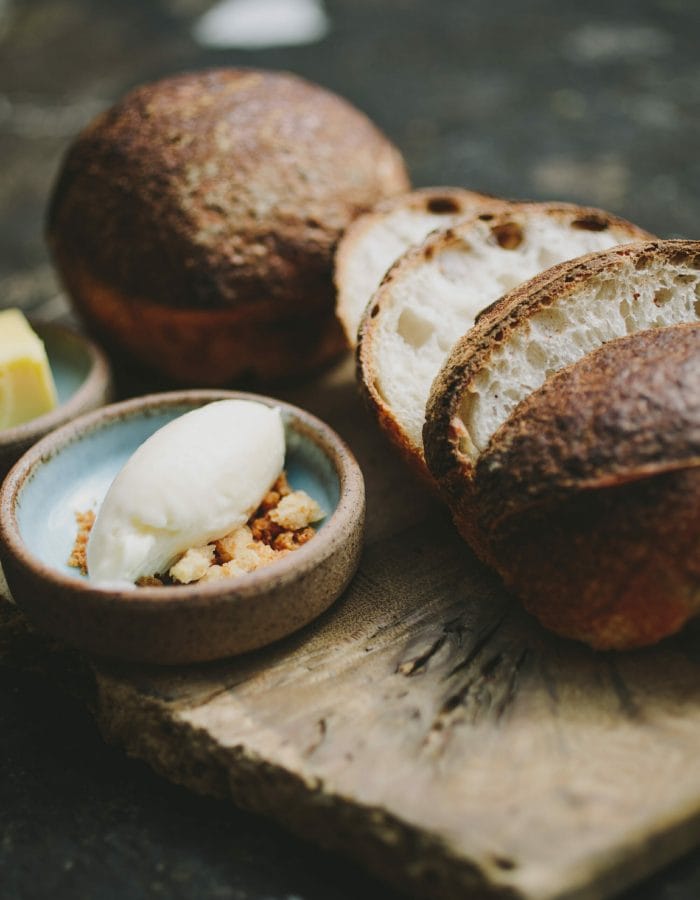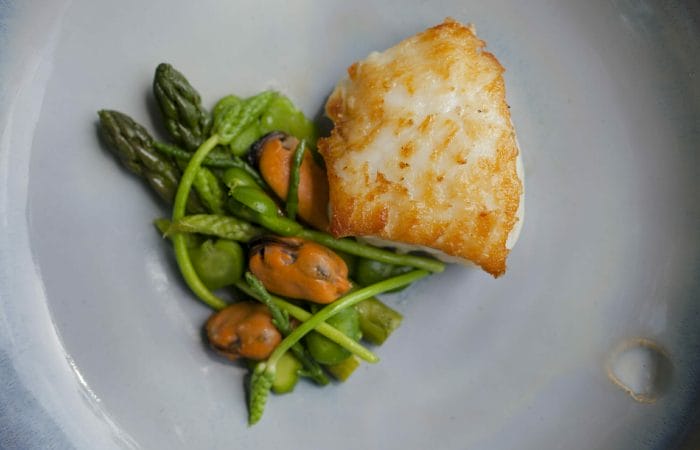
MEET THE MAKER
JON + GILL
Meet Jon and Gill; the Potter and Carpenter who craft their wares at Sytch Farm. We chat with Jon about the beauty of imperfection, the natural qualities of wood and clay, and the experience of collaborating with chefs.
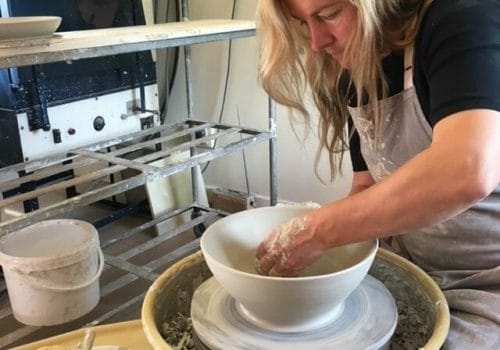
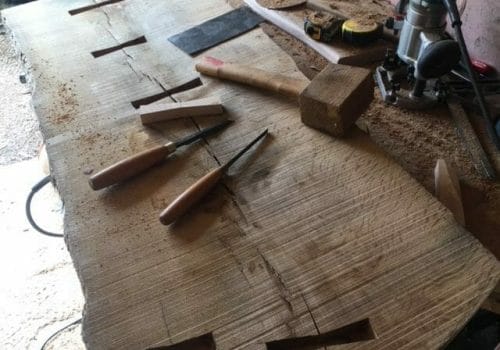
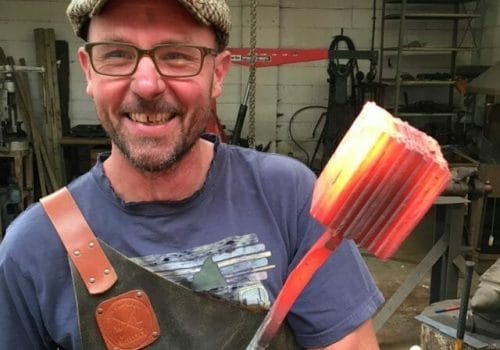
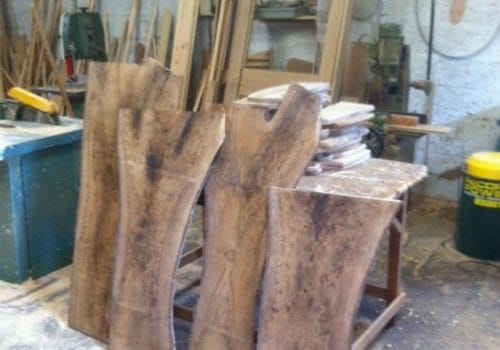
If you’ve dined at Peel’s then you’ll have eaten from Jon and Gill’s handmade goodies. Perhaps you didn’t notice the texture of the pottery, that shade of blue, the imprint of an ammonite with a thumbprint behind it or the shape of the wooden boards following the weave of the grain. But we think that it’s these details that take an ordinary experience and make it a treasured, aesthetic and sensual one.
In an interview with Ceramics Review, Gill spoke about the time she spent at her friend’s family home in Lake Annecy in France following her degree. She mused on the pottery in their kitchen:
They had pieces going back to their wedding and beyond and I was struck by how different it felt to handle ‘real’ plates and bowls every day, and how precious they were. There was a strong sense of a relationship with the maker, the materials and the purpose of the pieces. I want my work to feel that precious and involved in day to day life.
Gill has qualifications in art and design, a masters in ceramics and spent 16 years teaching art, design and ceramics. But five years ago she moved to Sytch Farm in Shrewsbury and set up her pottery studio. With her was her husband, Jon, a carpenter and general maker of things who honed his craft from kitchens and furniture to kitchen pieces that celebrate the natural qualities of the wood’s grain. Together they make the treasures that Gill was so inspired to create.
What kind of pieces make up your kitchen now at Sytch Farm?
Jon: ‘Our kitchen is an eclectic mix of pieces. We tend to have a lot of our own stuff; typically experiments which are just too complicated to make more of. But alongside these quirky pieces, we have a lot of work from other people. We find that people in this industry are very supportive of one another.’
Can you name and shame any potters that you love?
J: ‘I collect tea bowls; not always for drinking tea, but sometimes for an after-dinner tipple of whisky or the like. Personally, my favourite potter for tea bowls is Phil Rogers. And then we have a good friend called Ben Brierley. He’s an old student friend of Gill’s, but now he teaches ceramics at Loughborough. He makes some really quirky and characterful stoneware.’
Why handmade over machine made?
J: ‘As makers, we have complete appreciation of what goes into craftwork. The other day a friend describes the aesthetics of my chopping boards as ‘Wabi-Sabi’. It’s not something I’d ever come across and she actually sent me a lovely book all about it. Wabi-Sabi is the Japanese world view based around seeing the perfection of imperfection.
When you pick up one of Gill’s pots it’s not quite round. That’s because when she marks her pieces with an ammonite (it’s a bit of a trademark now), she leaves a thumbprint on the inside. It’s the same if you pick up a pot from 1000 years ago; you’re able to decipher the maker’s thumbprint. Don’t get me wrong, there are some manufacturing firms with a fantastic heritage, but you don’t get that same kind of connection with the maker; a sense of the love and detail that they have put into their pieces.
Now, more than ever, the idea of perfection has moved on. Robots can do everything better than we can, so something that is perfect isn’t made by human hands and that is a real loss. I think there’s a bit of a Renaissance now; people are falling in love all over again with the handmade. Yes, it does cost a bit more, but you have that real sense of connection with the creator.’
To what extent do the materials you use dictate the final piece?
J: ‘I used to build kitchens and all sorts in wood. When you’re making furniture and pieces with specific requirements then you chuck away the pieces of wood that are difficult to work with. But the move to Sytch Farm was a push into the ceramics, so I started doing the kind of woodwork I do now to support Gill. Friends would say ‘are you not bored of working on such a small scale’, but it gave me a real appreciation for wood as a material. Now I create pieces based around the characteristics of the wood that before I’d have been required to chuck.
Gill uses Cornish clay which comes from where she grew up, St Agnes. She remembers using the same clay in primary school, so there’s a sense of nostalgia for her. It also happens to be a really nice clay to throw with; smooth and strong but can be thrown to create something really delicate. She has a real connection with the material. In fact, we ran out of clay last week, and whilst we were waiting for a delivery we got a couple of similar bags to tide us over. As soon as Gill stuck it on the wheel she could tell the difference. Throwing this clay has become her second nature.’
Are there any times that stand out for you in terms of seeing your pieces in action in restaurants?
J: ‘A huge moment for us, for Gill particularly, was the first time that it ever happened. That was for Tom Kerridge, and we couldn’t have asked for a better start. We were chatting to him at a show and he said ‘I’ve been working on a dessert for six months but can’t find a bowl for it.’ He gave his specifications and off we went. We visited him a while later and he said ‘you’re going to have to try this dessert in your bowl.’ That was definitely a pivotal moment for us.
And then, of course, one of the nicest relationships has been with Hampton Manor. James and Fjona just ‘got it’ from the start. They visited Sytch Farm in the early days with Rob and Craig. We laid everything out on a table and, whilst sipping on coffees, they discussed what their menu was like, the size of the portions, their plans for future dishes. They said ‘this is the right colour, but that’s how big the dish is, so we need a plate to be wider so we can see more of the blue…’.
When you’re making something there’s a thought process from start to finish that goes with it. The chefs that we work with are as passionate about food as we are about our pottery and boards. It’s a collaboration, a shared experience and a lot of craftspeople enjoy the process.’
Jon and Gill are absolute foodies who exchange their wares for meats and cheeses with their neighbours in Shropshire. Check out Jon’s joy-inducing meatball recipe here and treat yourself to a scroll through their Instagram.
